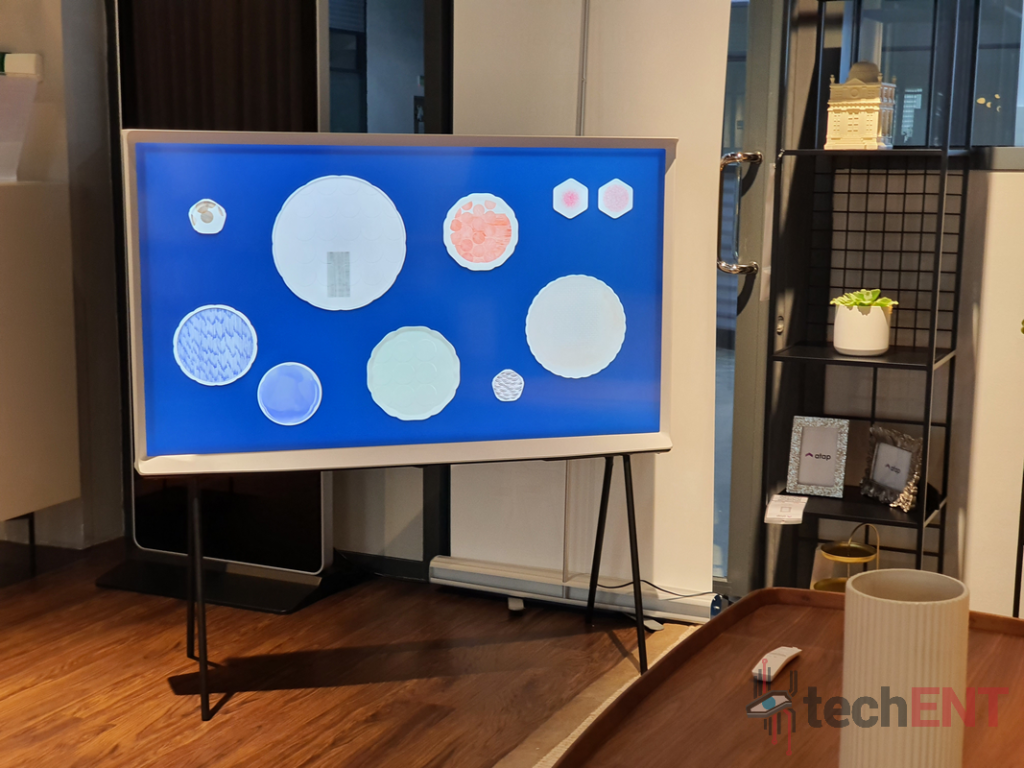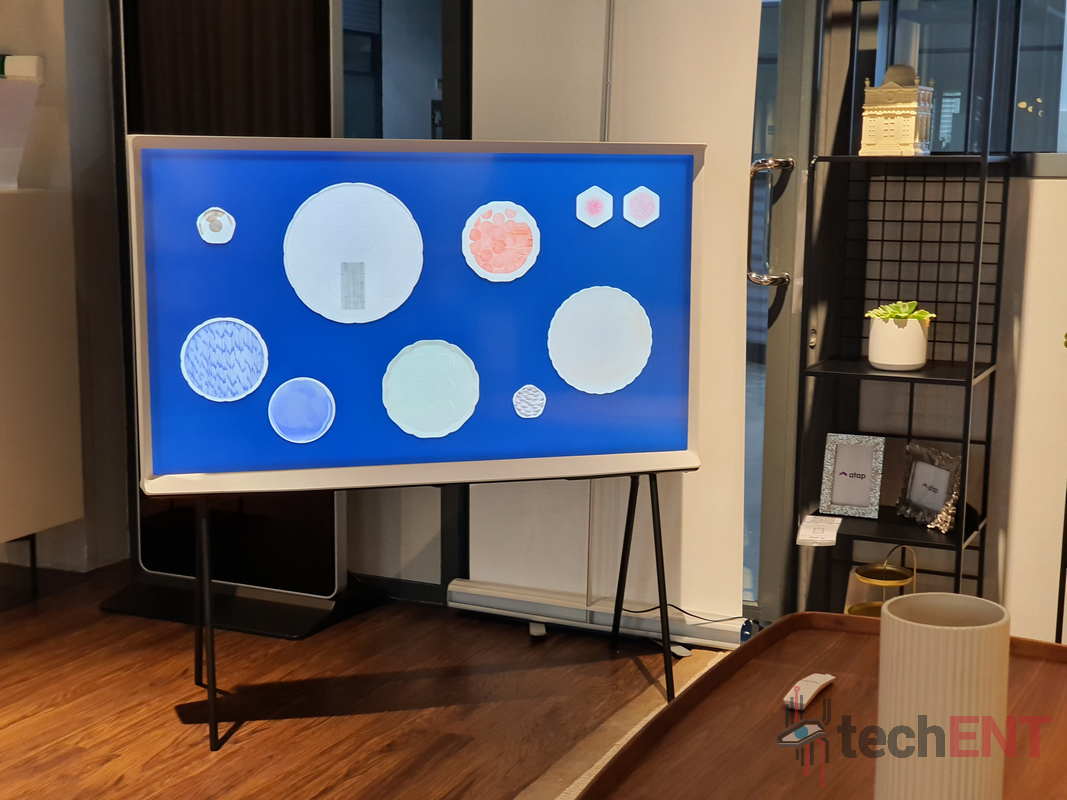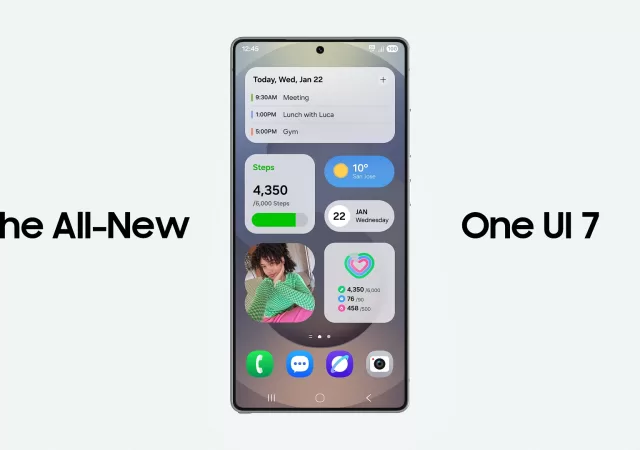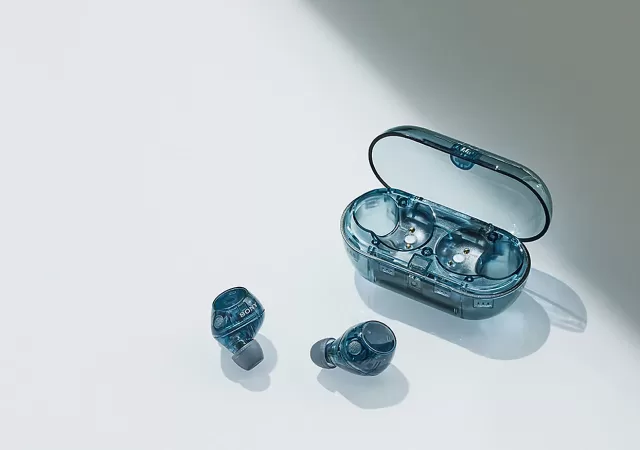The television isn’t just a screen to consume content anymore. Over the years, the screen has become more of a multi-dimensional surface which isn’t just about multimedia. Some use it to keep in touch, some use it to escape the world while others use it as a statement piece in their homes. So what happens when a company invests more time and effort into making a screen that doesn’t only serve it’s interactive purposes but also helps users create that statement piece to pull a room together? Well, in short: you have the Samsung Serif.
The Serif joins a line up of Smart TVs that occupy a unique niche they’ve come to call “Lifestyle TVs”. This line up with initially started with Samsung’s The Frame TVs is now populated by The Serif, The Sero and The Frame – each built with a unique feature to set them apart.

So, how does The Serif set itself apart? Is it worth an investment? Should you even care about it? Those are some of the questions we’re looking at with the in-depth review of The Serif.
Design
When it comes to design, The Serif is bound to turn heads. Samsung worked with renown design brothers, Ronan and Ewan Bouroullec. The Bouroullec brothers brought a fresh, innovative take on the TV and how it can be used in any room as a statement piece. It takes the drab, reflective rectangle and breathes new life with a unique, head turning design.
The first thing you’ll notice about the Samsung Serif, is its side profile, which, like its name suggests highlights the features of the “I” in serif. The curved top and bottom portions of the TV not only act as design accents but also provide some functionality – as a sturdy base in the case of the bottom, and as a surface for your trinkets in the case of the top. In addition, the design accents actually provide some relief from glare resulting from light sources in the room.




That said, the Serif is designed to stand out. Its unique “I” design is complemented with a heavy, and I mean HEAVY, base. This allows you to stand it anywhere – a feature we delve into further later in the review. It goes without saying that the overall design language of the Serif will make it stand out no matter which room it is in. We got to review a white coloured Serif – the only colour available in Malaysia at the moment and it was the first thing that caught your eye as soon as you walked into the room. The TV is available in Black and Red in other countries.
The unique, understated design of the Serif creates a sense of drama which is apt for an entertainment surface. However, it is also designed in a way that you’re not hard pressed to place the TV against a wall. It has a cohesive design which leaves no port exposed thanks to a panel on the back which ensures that there are no exposed surfaces which are jarring to the eye.
Features
Stand anywhere & hide cables away
As mentioned earlier, the design of the Serif allows you to stand it anywhere. The bottom surface of TV is weighted with a heavy, thick metal base to provide stability. In fact, the TV is stable enough that even a sudden, hard jerk to the TV won’t send it toppling over. It’s thanks to this stability and weight that the Serif is able to be placed on any surface independently.
However, if you don’t want to place it on a table or mantle, you can also stand the TV independently. The Serif also comes with stilt legs which can be screwed into the base. This allows you to stand it independently.





In addition to being able to stand alone, the Serif also comes with a built-in cable management system. This starts with the back of the Serif where a backplate made of plastic and covered in fabric hides the HDMI, USB, Antenna port and more. These cables are then channelled through a hole in either end of the Serif. Through this hole, the cables are run along the nearest stilt leg with a plastic clip; keeping the mangle of cables clean and managed.
While convenient, Samsung’s approach to cabling and wire management in the Serif seems counter intuitive and dated. In fact, it is contrary to the approach Samsung has been pushing in its own QLED flagships with the single cable and connectivity box. The biggest gripe we had with the design of the cable management is the fact that the design tucks away the ports of the Serif, making them inaccessible – particularly the USB port which you are likely to use most often for pictures and other multimedia. To access this port, you need to pry open the back panel and replace it. Not too tedious but if you place it against a wall, this would mean that you have to move the whole TV to access the ports.
NFC tap to Play (Music) & Dynamic Wallpaper
One of the features that we ended up using most when reviewing the Serif was the Tap to Play feature. This NFC powered feature allows you to simply tap your NFC enabled device to connect wirelessly to the TV and play music from any of your installed apps. We mention music specifically cause it’s the only media you can use the feature with. You can’t play videos or project pictures using the Tap to Play function. That said, the Tap to Play function is also able to wake the TV. All you have to do is place your smartphone or tablet on the top of the Serif at a specific position. This is subtly marked for easy identification by an NFC logo.

In addition to this, the Serif comes with Dynamic Wallpapers which allow the screen to show you useful information when you’re not using it for entertainment. The default wallpaper comes with the date, weather, and clock. The dynamic wallpaper is also a key component of the Tap to Play function. It pulls up a wallpaper which response to the beats of the song you’re listening to. It also changes the visual ambience based on the genre you’re listening to.
Samsung’s Tizen OS, BixbY & SmartThings
Samsung’s continues to use its Tizen OS on the Serif. That said, they have optimised it to be less intrusive and more functional than ever. Of course, these improvements came with their flagship QLED TVs. However, it’s nice to see that even models like the Serif are getting the same software.
Tizen OS is lightweight and responsive on the Serif. It actually makes setting up the TV pretty easy with your smartphone through the SmartThings app. Simply connecting the TV on the SmartThings app and setting up the TV from your phone removes most of the tedious setup such as setting up WiFi. The SmartThings platform allows you to import your settings from your smartphone to the TV directly without needing to type your passwords on screen.
After setup, the SmartThings App also allows you to use an on-screen remote control on your smartphone to control the Serif. This control extends to Samsung’s own smart assistant, Bixby. While you need to hold down the voice control button when you use the remote control. If you’re on a Samsung device, a simple “Hey Bixby” allows you to get the Serif to launch your favourite apps or shows on screen.
The Serif also supports Apple AirPlay 2, so if you’re on a Apple device, you’ll be able to connect and access your content just as easily. Perhaps where Tizen OS shows Samsung’s focus on software compatibility is when it comes to Screen mirroring. It goes without saying that Samsung’s own devices are smooth as butter. However, when it comes to other brands such as Apple and the dreaded wireless mirroring on Windows, the Samsung Serif has been one of the most reliable and stable we’ve reviewed to date.
Picture & Sound Quality
The Serif comes with a 4K UHD QLED panel – one of Samsung’s forte’s when it comes to displays. It remains the same with the Serif. The panel that Samsung is using for the new lifestyle TV is bright, saturated and has good contrast. Blacks are deep and whites are bright but not jarring. That said, the panel did have a slightly darker tint compared to other QLED TVs we’ve seen before.

Just like in its flagship QLED TV line up, the Serif also comes with software enhancements for its picture quality. It has a smoothing feature which is supposedly able to make motion less jerky and fluid. This feature was pretty effective on animation content. When we watched show like Studio Ghibli’s Spirited Away or Netflix’s Dragon Prince, motion was more fluid, and the viewing experience was more enjoyable. However, when it came to acted content such as The Resident or even The Hamilton Musical, movements were fluid but there was a significant amount of ghosting happening. Actors’ looked like they had their spirits leaving their bodies while they were moving. Of course, this is easily remedied by simply turning the functions off.
One of the best features on the Serif is Samsung’s intelligent mode for picture and sound. This function learns your viewing behaviours and adjusts the settings according to your preferences. In our review case, we were turning the brightness down in dark situations to reduce eye strain. Once the preferred brightness level was set, the Serif intelligently returned to it every time the sensors detected a drop in ambient light. It also helped compensate for levels between the default and preferred setups. The Serif does also come with an ambient sensor which helps with the intelligent setting.

When it comes to audio, the Serif has one of the better speaker setups built in. Unlike some other TVs, this TV has proper speakers built in. The speakers are clear and crisp for dialogue and have good frequency range. It was able to reproduce a good amount of low frequencies and high ones. This led to a rather enjoyable sound experience on its own. In fact, during our review period, the volume rarely went above 20.
A Functional, Well Designed, Functional Statement Piece for Any Room
The Samsung Serif is one of the more unique Smart TVs out there. It’s design allows you to accent any room with a statement piece which will undoubtedly become the focal point of the room. That said, the design of the Serif also allows it to seamlessly blend into room – if the design requires it. However, the smart TV’s design isn’t without its flaws particularly when it comes to port accessibility. Keeping them under a panel is aesthetically pleasing but when it comes to utilising them it becomes tedious. This is particularly true when it comes to the USB port.
That said, it does provide a unique overall package complete with good speakers, great picture quality and a bevvy of features. This creates a unique, compelling proposition looking for a smart TV that can double as a statement piece in any room. However, being slightly higher on the price side of things at MYR6,499, the Serif makes a tough proposition for those of us not looking for a design-centric TV. In fact, put side by side with Samsung’s flagship line up at the same price point it can seem a little anaemic and gimmicky when it comes to features. That said, the minimalist and functional design does win it some brownie points. Overall, it’s got us on the fence. It would be amazing if Samsung’s next Serif brings even more technical features to make it a more complete and compelling offering at its price point.






